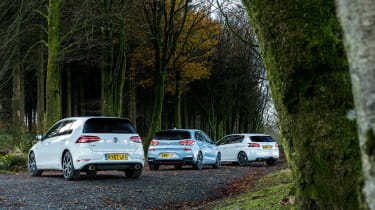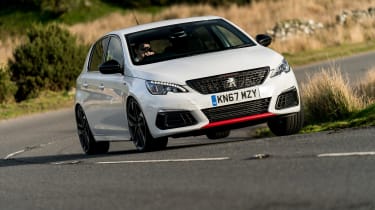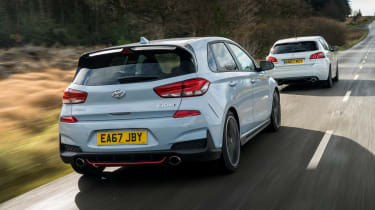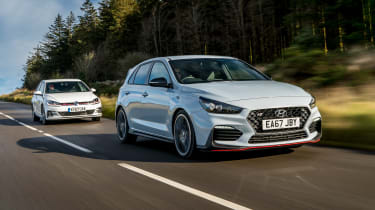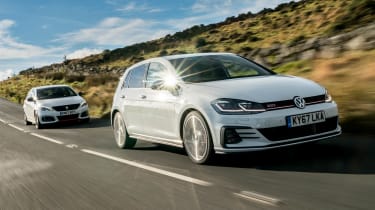Hyundai i30 N vs VW Golf GTI vs Peugeot 308 GTi review
Can the new Hyundai i30 N overcome a pair of hot hatch rivals in the shape of the VW Golf GTI and Peugeot 308 GTi by Peugeot Sport?
You can't really fault Hyundai’s ambition. With no real high-performance heritage to speak of, the Korean brand has climbed up to the highest board on the diving tower and taken aim at the deep end. It could have stuck to doing what it does best, which is churning out worthy but dull hatchbacks and SUVs that are long on warranty but short on fun, but the company wanted to inject some excitement into its rather humdrum image, and the result is the i30 N.
This isn’t some tepid toe-in-the-water exercise like sister firm Kia’s warmed over Proceed GT, either – this is a proper, no-expense-spared job. How proper? Well, former BMW M head honcho Albert Biermann has been the technical driving force behind the i30 N, and his back catalogue suggests he doesn’t on the whole do duffers. This theory appeared to hold true when Steve Sutcliffe returned from the car’s overseas launch (evo 241) singing its praises. From out of nowhere Hyundai had delivered a hot hatch that wasn’t just good for a first effort, but good period. Yet before we can give the i30 N a true evo seal of approval, it has to impress both here in the UK and against some formidable rivals, which are themselves in tip-top shape thanks to recent revamps.
> Click here for our review of the Hyundai i30 N
Before even turning a wheel on any of the testing Dartmoor roads we’ve chosen for its fast-hatch baptism, it’s clear the Hyundai means business. Finished in the brand’s WRC-inspired Performance Blue, there’s also a black front splitter, red stripes front and rear, arch-filling 19-inch alloys and a prominent tailgate spoiler. We’ve got the flagship Performance model here (there’ll be a lower-powered version in time), its turbocharged 2-litre four-cylinder boasting 271bhp and 260lb ft of torque – although there’s 18 seconds’ worth of 279lb ft overboost if you keep your foot in. These outputs are channelled through a six-speed manual transmission to an electronically controlled limited-slip differential. Other high-performance badges of acceptability include Brembo brakes, adaptive dampers and multiple driver modes. There’s even a rear strut brace.
The £27,995 Hyundai isn’t the only ‘Performance’ tagged machine here, because the latest, version 7.5 VW Golf GTI can be ordered in two heat levels – standard tune is 227bhp, while the 242bhp GTI Performance sits just above it. It costs more – from £30,475 in i30-matching five-door form – and is a little down on power in this company, but additions such as a trick front diff, adaptive dampers (an £830 option) and larger brakes give clues to the Volkswagen’s intent. And while it’s not as aggressively styled as the Hyundai, its melding of perfect proportions, subtle aero additions and that iconic red stripe mark it out as something a bit special.
By contrast, you’d be forgiven for losing the £28,590 Peugeot 308 GTi by Peugeot Sport in a motorway services car park. A recent spell under the knife has resulted in the same bulbous nose treatment as the brand’s burgeoning range of high-riding SUVs, but in all other respects it looks like a humdrum five-door hatch. What makes the forgettable exterior so hard to forgive is that it hides some choice mechanical modifications. The turbo 1.6-litre’s headline figure of 266bhp gives it the highest specific output, and it also features a specially reinforced block, forged pistons and a single twin-scroll turbocharger.
> Click here for our review of the Peugeot 308 GTi by Peugeot Sport
Other highlights include dustbin lid-sized Alcon brakes that can trace their roots back to the 206 WRC, and a proper Torsen locking differential. Like the Hyundai, a six-speed manual is the only transmission option (the Golf can be had with three pedals as tested here, or with the latest seven-speed twin-clutcher), but the 308 stands alone in having purely passive dampers. The final ace in the French car’s pack is its minimal mass, with our scales recording 1316kg for the 308, the Golf returning 1408kg and the i30 a hefty 1477kg.
I chose the Hyundai for the long schlep down to Devon and it isn’t hard to fathom where its weight problem might stem from. The interior is solidly constructed from decent materials and is packed with all the gadgets that we’re told the modern consumer demands, including multi-way electrically adjustable front seats. These high backed, heavily bolstered items are set just about low enough and are hugely supportive, while the correlation between the thick-rimmed wheel, pedals and stubby gearlever is just about perfect. There’s decent heft to the steering, too, hinting at the car’s potential and allowing you to strike up an instant relationship with the road, while the short, quick and precise gearshift comes close to matching that of a Honda Civic Type R.
When taking it easy the i30 N feels remarkably refined and grown-up. There’s a burble from the exhaust at idle that sounds like it’s been carefully modelled on an i20 WRC in ‘road mode’, but for the rest of the time the engine is the model of restraint, rarely rising above a background hum and only making itself known via its effortless mid-range urge. Meanwhile in Comfort mode the dampers serve up a supple and quiet ride.
> Click here for more on the Honda Civic Type R
In many ways the Hyundai feels very like the VW, which comes across as a mini executive saloon when taking it easy. The trademark checked trim, red stitching, dimpled gearknob and low-set driving position combine to give the GTI a sense of purpose, but the rest of the cabin is pure Golf, which means a sea of soft-touch materials and an aura of understated class. It’s also the most quiet and cosseting of our trio, particularly when it comes to the ride, its adaptive dampers rounding off the worst of the winter-ravaged roads. Only the distant growl of that trusty EA888 2-litre offers a reminder of the VW’s performance intent. That and its instant throttle response, which gives the sense that the GTI is attached to the horizon by a giant elastic band – there’s a wall of torque from about 1500rpm onwards.
In fact, it’s the dull-looking 308 that gives off the most go-faster vibes on the move, even when taking it steady. Much of that is down to its ride, which is firmer and busier than those of its rivals here. It would be going too far to call it uncomfortable, but the passively suspended Peugeot fidgets and hops over imperfections that the Golf in particular steamrollers into submission. The 308 also feels different from behind the wheel, which is small and flat-topped. It’s designed this way to allow drivers to see the high-set ‘i-Cockpit’ dials; this arrangement works for me, but others find the wheel rim masks the dials.
There are more frustrating quirks, too, such as the poorly placed pedals (they’re set high and strangely angled) and the chunky alloy gearshifter, which feels awkward in your hand and is connected to a mechanism that’s long on throw and a little short on precision. Still, the squashy, high-backed seats are remarkably comfortable and supportive, and the 1.6-litre engine is the sweetest here, spinning freely and smoothly and being barely audible at a cruise.
As we climb up onto Dartmoor I fully uncork the Peugeot’s motor for the first time. My word it’s quick, easily leaving the Hyundai and Golf to play catch-up if their drivers are caught napping. When we later bolt our timing gear to the 308 it streaks from standstill to 60mph in a scorching 6 seconds dead – five and six tenths quicker than the Golf and i30 N respectively. Yet the numbers only tell half the story, because it’s the way the 308’s engine deploys its performance that really gets the adrenaline pumping. It doesn’t have the rippling low-down torque of the 2-litre duo, but it spins with far more enthusiasm, while the way the power builds with a sudden, exhilarating rush towards a raspy, red line chasing crescendo is truly addictive. Even the gearshift improves, experience revealing that you need to be quick and positive to get the best out of it.
Simply put, the Hyundai and VW are left trailing here. Perhaps most surprising is the i30 N, which never feels as potent as its best-on-test power output suggests. It’s hardly slow, and once the revs climb beyond 4000rpm it goes as hard as the Peugeot, but there’s a lethargy to its low-speed response that suggests it is struggling to overcome the inertia of its higher kerb weight. However, engage Sport or Normal mode using the large Drive Mode button on the steering wheel and you’ll get good throttle response and a grin-inducing fusillade of pops and bangs from the exhaust. The combination of crackling soundtrack and wrist-flick gearchange encourages you to keep the engine on the boil, making the most of that top-end bite.
The Volkswagen falls between the Peugeot and Hyundai here, both in terms of absolute performance and delivery. Its engine feels the most muscular at low revs, yet will spin around to its 6500rpm red line with similar smoothness and eagerness as the Peugeot. It’s not as vocal as the other two – there’s a satisfyingly bassy metallic growl when you’re really gunning it, but that’s about it – but it’s undeniably effective, and for sweat-free cross-country progress the Golf takes top honours.
The chassis plays its part here too, because it has clearly been tuned with ultimate composure and predictability in mind. In its most aggressive settings the GTI feels nicely hunkered down without ever becoming harsh; the steering is precise and direct and just talkative enough, and the front end bites hard on turn-in while the rear axle takes its share of the burden without becoming wayward. Body control is strong too, and Dartmoor’s rollercoaster tarmac never catches the Golf’s damping napping. Only the diff causes concern, with the electronic unit occasionally getting confused and pushing the nose wide rather than pulling it into the apex.
That’s not an accusation that can be levelled at the Peugeot’s purely mechanical locker, which proves brutally effective and encourages you to open the throttle earlier and earlier, just to feel its uncanny ability to keep the 308’s nose magnetised to your chosen line. Yes, there’s some torque-steer on the exit of bumpier corners, but it never gets out of hand and is a small price to pay for the Peugeot’s stonking traction.
In fact, the whole driving experience is more physical, interactive and engaging than the polished Golf’s. There’s the spirit of the 205 GTI lurking here. Really. At first the steering feels slow to react and there’s a curious dead feeling about the straight-ahead, but trust the grip will be there and the Peugeot clings on hard all the way from entry to exit. Yet there’s also real balance in the handling, and you can subtly alter your line with either a touch more steering or a little lift of the throttle. Be more aggressive with your inputs and bring those powerful and progressive brakes into play and, with the stability control disabled, the Peugeot’s rear will step surprisingly wide, requiring a quick and positive response to get things back on track. I told you it had more than a hint of 205 about it… It demands more concentration and respect than the VW, but the rewards are much greater.
String together the same corners in the Hyundai and it instantly feels like a more serious device than the other two – in many respects it’s more Type R than GTI. There’s a tied-down solidity to its demeanour and the steering has a meatiness that brings to mind Herr Biermann’s previous creations – although there’s still not as much feedback as we’d like. Sport mode is just about perfect for these roads – Comfort is too soft, while the rigid-riding N mode is best reserved for the racetrack. The i30 doesn’t feel as light on its feet as the featherweight 308, but the way it simply demolishes these moorland roads is deeply impressive. It’s the grip, stability and precision that really take your breath away – you can lean harder on the brakes and the front tyres than in the other two, while the cast-iron body control remains totally unfazed by anything you throw at it.
The electronically managed diff also does a better job than the Golf’s similar set-up, consistently drawing the i30’s nose back on track and allowing you to unleash the engine’s thrust nice and early. Yet the N isn’t a one-dimensional device that simply picks apart a B-road without batting an eyelid. Sure it’s not as expressive as the acrobatic Peugeot, but start to play around and you can subtly alter the car’s attitude into, through and out of corners – it’s fun as well as fast.
So it’s a win for the Hyundai, then? Ultimately the answer is yes, but these cars are so closely matched, while offering subtly different approaches, that this is a tough one to call. All three are rapid, grippy, spacious enough for a family, not outrageously expensive to buy and will easily return 30mpg. Of the three, the suave and sophisticated Golf is the easiest to live with, but its broad spread of abilities means it’s just not as engaging when you really want to roll up your sleeves and just drive for the hell of it – it’s 95 per cent there, but lacks that last five per cent of magic. As a result it takes the lowest step on our close podium.
On the right road and with the shackles off, the Peugeot is the greatest entertainer and is sheet-metal proof that the French firm hasn’t forgotten how to have fun, while that engine is a real cracker. And we applaud Peugeot for making the 308 so light – it’s no coincidence that it was the fastest yet used the least fuel. The i-Cockpit remains a bone of contention and the gearshift needs work, but dynamically the raw and edgy GTi hits the spot. So Peugeot, how about a bit more visual aggression and, oh, I don’t know, a Rallye version?
Yet both have to give best to the remarkable Hyundai. It’s a brilliant hot hatch, but it also feels like a proper, mature performance car – a car that has an aura of being very thoroughly developed. We’d like it to be a little lighter, which would unshackle some of the engine’s latent pace, and perhaps have a touch more steering feel, but in all other respects it’s a remarkable effort, striking a fine balance between the Peugeot’s playfulness and the Golf’s utility. We have a new hero, and it comes from a very unlikely place.

